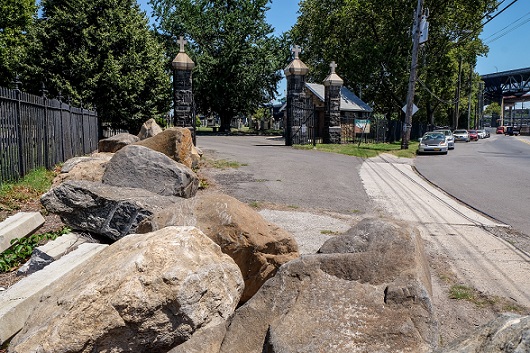Several oversized rocks are scattered throughout our area; some are celebrated, others are hidden in plain sight. A few of these rocks have recent historical significance (“recent” defined as being within the last 400 years), but all of them date back to a time before human existence. These boulders are known as “glacial erratics” meaning that they were carried here from elsewhere by melting glaciers more than a hundred thousand years ago. Glacial erratics are made of minerals that differ from those found in local bedrock. Most erratics found in Queens are made of granite while the bedrock under us is mainly a combination of gneiss and schist.
The most famous glacial erratic in our area is “Arbitration Rock” located in the yard of the Onderdonk House along Flushing Avenue. This rock is believed to have been one of three large boulders that served as markers to delineate the boundary line between the towns of Newtown in Queens and Bushwick in Brooklyn in the 1700s. Legend has it that there once was a line down the middle of each rock with one side marked “B” and the other side marked “N”. This rock had disappeared decades ago and it was assumed that it had been dynamited into oblivion. Queens librarian and historian William Asadorian thoroughly researched the matter and concluded that the rock had actually been buried underneath Onderdonk Avenue in the 1930s. It was unearthed during roadwork and moved to the Onderdonk House in 2001.
As mentioned previously, along with Arbitration Rock, two other glacial erratics served as border markers during the 18th century. It is possible that they still exist today. There is a large boulder on Varick Avenue and Randolph Street in Bushwick that has been painted green to match the fence next to it. Historians believe this rock has not been moved for centuries and sits on what was the original border between Brooklyn and Queens. The third boulder was likely on Morgan Avenue near the appropriately named Rock Street until about 2008. It has since been moved to an unknown location by the owner of the private lot in front of which it sat.
Then there is the gigantic boulder located in Elmhurst Park, tucked away in the northeastern corner, near the Grand Avenue side. This 7-foot tall, 4-ton glacial erratic was dug up by a sewer contractor excavating Vanderbilt Avenue in Fort Greene, Brooklyn in 2006. Upon learning of the find, Queens Parks Commissioner Dorothy Lewandowski requested that it be incorporated into the design of the yet-to-be-constructed Elmhurst Park, and it was transported there. The provenance of this particular boulder was found to be the Ravenswood section of Long Island City. An outcropping of exposed bedrock there, known as “ravenswood granodiorite”, matches the material found in Elmhurst Park’s enormous rock. Scattered boulders are also features of the landscaping throughout Grover Cleveland Park and one is prominently displayed in Juniper Valley Park at the corner of Lutheran Avenue and Juniper Blvd South.
For many years, a smaller glacial erratic sat right out on the sidewalk at a Q38 bus stop located on Penelope Avenue at Dry Harbor Road. It was painted white, likely by a local homeowner. This rock disappeared circa 2013 when a new sidewalk was installed and its current whereabouts are unknown. A much larger boulder is present in the small plaza located just outside the western entrance/exit of the Flushing Avenue LIRR underpass.
Cemeteries are great places to find glacial erratics as excavation is constantly occurring at them. Along the fence on the 50th Street side of Third Calvary Cemetery in Maspeth sits a row of boulders. Just west of the entrance to Old Calvary Cemetery on Laurel Hill Blvd, some of these giant rocks were arranged into sidewalk decorations. The 9/11 memorial at Lutheran-All Faiths Cemetery is also made from a glacial erratic that was unearthed during a grave excavation.
Many of our public memorials are comprised of glacial erratics as well. These include memorials at Drumm Triangle in Glendale and at Maspeth Memorial Park.
Glacial erratics are “happy accidents” that hold an important role not only in the field of geology, but also history, both ancient and modern.
This article is dedicated to Maxwell “Mickey” Cohen, who taught me much about geology.




